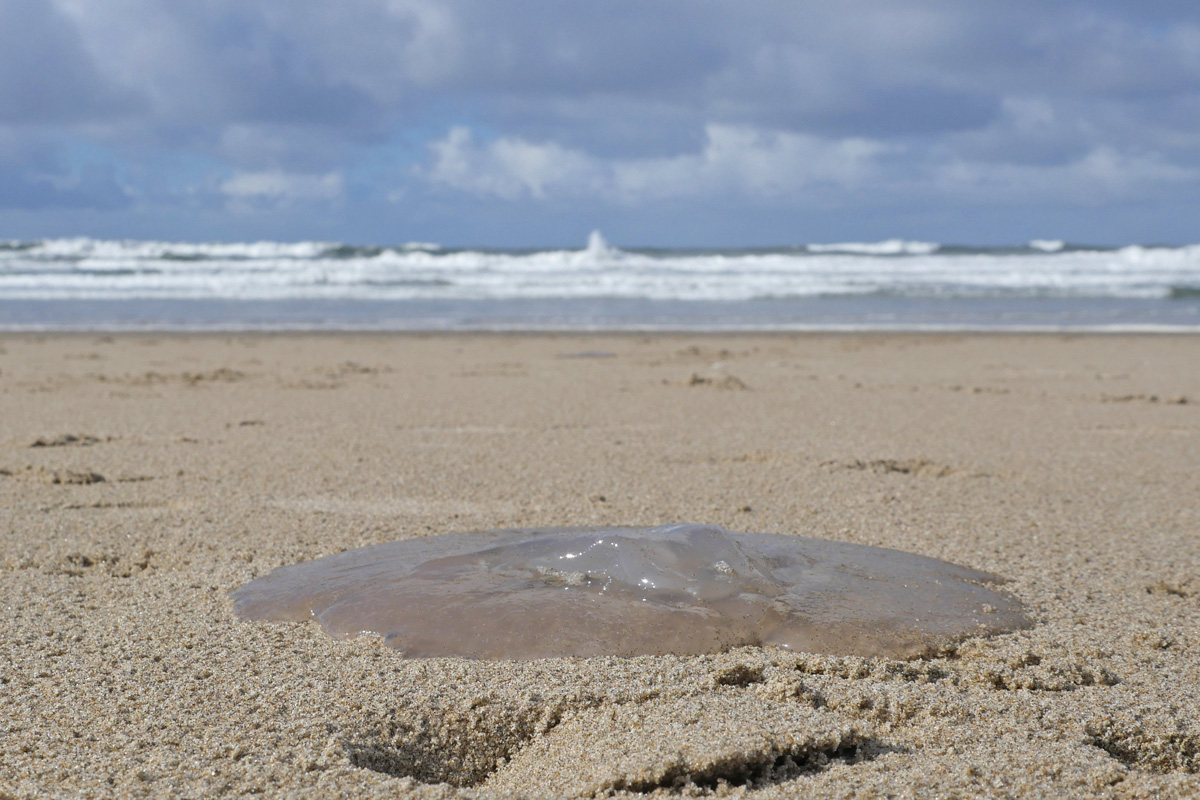Take a walk on the beach to get a glimpse of Oregon’s marine ecosystems.
You can explore the ecology of the Oregon Coast by simply taking a walk. Twice a day, every day, the tides sweep in and out, carrying signs of marine life along with them. If you’re walking on the beach, don’t just watch the waves — check out the jetsam and flotsam that wash up on the beach. Some of it is mysterious, and some of it has an otherworldly beauty. If you’re lucky, here are a few of the finds you might encounter.

Jellied Creatures From the Deep
Water or crystal jellyfish are not particularly remarkable if encountered on the shoreline, where they look like little more than a translucent water balloon, but suspended in the ocean, they have a parasol shape and their bioluminescence makes them glow like the moon. On the shore, they appear very similar to moon jellyfish, another translucent and often beached type that’s also frequently found on display at the Oregon Coast Aquarium.
Keep your distance, however, from big jellyfish with a reddish-orange color. It might be a Pacific sea nettle, whose tentacles can sting humans.
Possibly the only jellyfish recognized by its Latin name, Velella velella, because it’s so fun to say, these tiny jellies sport an indigo-blue sail-like structure atop a flat base that is the source of their common name, by-the-wind sailors. They are typically only seen in early spring, when they wash up in masses on certain beaches, at the mercy of changing spring winds as they sail on the water’s surface.
One other invertebrate that you might not recognize as readily is sometimes called a sea pickle. Often the size of a finger, though they can grow to the size of a cucumber or larger, tube pyrosomes are bioluminescent, hollow tubes with a Jello-like texture. Though they grow most readily in more tropical waters, storms and other ocean disturbances occasionally carry these organisms to Oregon’s coast, sometimes in large numbers.
Castoffs and Castaways
Find one of these leathery pods with their horny ends and you’ll understand why skate egg cases are sometimes called mermaid purses. They are in fact designed to hold something, but it’s not lipstick. They’re the protective coating for the eggs of skates (also called rays) which flourish in Oregon’s waters and can grow as large as 8 feet across from wingtip to wingtip.
Find what looks like a rock riddled with lots of little crisscrossing holes? It may look like coral, but it was once home to a colony of worms. These worms don’t tunnel but rather extract calcium from the seawater and use that to create a shelter. As the colonies grow, pressure from surf can break pieces apart, which then wash up on shore as false brain coral.
Plants of the Sea
It might look like soap suds, but seeing fluffy clouds of seafoam along Oregon’s shoreline is no cause for alarm. The frothy tumbles are made from a suspension of air, saltwater, and proteins from algae, seaweeds and phytoplankton — microscopic plants — kicked up by the surf. A foundational food source for many small creatures, seafoam indicates the phytoplankton populations in the water are healthy and robust.
Bull kelp forests of massive, dark-brown seaweed grow along the Oregon Coast and are a foundational part of Oregon’s healthy marine ecosystems. It bears a tubular, hollow stalk topped with an orb-shaped bulb and a cluster of leaf-shaped fronds. Each winter you find mature specimens — often 10 or more feet long — broken free from their holdfasts on the rocky ocean bottom, tangled up in giant piles on the beach.
Also look for winged kelp, or wakame — a long, spear-shaped seaweed with a central stalk — and the purplish-brown, almost plasticky handfuls of porphyra, better known as purple laver or nori. It often is found with sea lettuce, which is similar in size and texture but a brilliant emerald green. Did you know all of the seaweeds listed here are edible? Always make sure that anything picked for personal consumption is from clean water, and check ODFW’s regulations for when and where it’s legal to harvest before you go.
Other Oddities
Also called whale burps (though they’ve got nothing to do with whales), beach balls are round tufts of tangled seagrass, snail egg cases, seaweed, and manmade materials such as fishing line that tangle together in the surf. They resemble balls of yarn and can be as small as an inch and as large as a foot in diameter.
Count yourself lucky if you find a hollow blue, green or gray glass float on the Oregon Coast. These highly collectible orbs were once used as floats for fishing nets. Nowadays, you’re more likely to encounter intentionally placed glass floats made by local glassblowing artists in Lincoln City and Gold Beach — and at antique shops up and down the Coast.
If You Go
- While it’s fine to handle most beachcombing finds, it’s recommended to “leave no trace” by minimizing the taking of souvenirs.
- Before you set out, you’ll want to check the weather report and the tide tables for great low-tide beachcombing.
- Never turn your back on the ocean, watch for swells and observe beach safety.
- Dress in layers and don’t forget sun protection.
- Take along a bag to collect any litter you see on the beach, or join one of the coast-wide SOLVE cleanup events to help preserve Oregon’s beaches.
– By Emily Teel